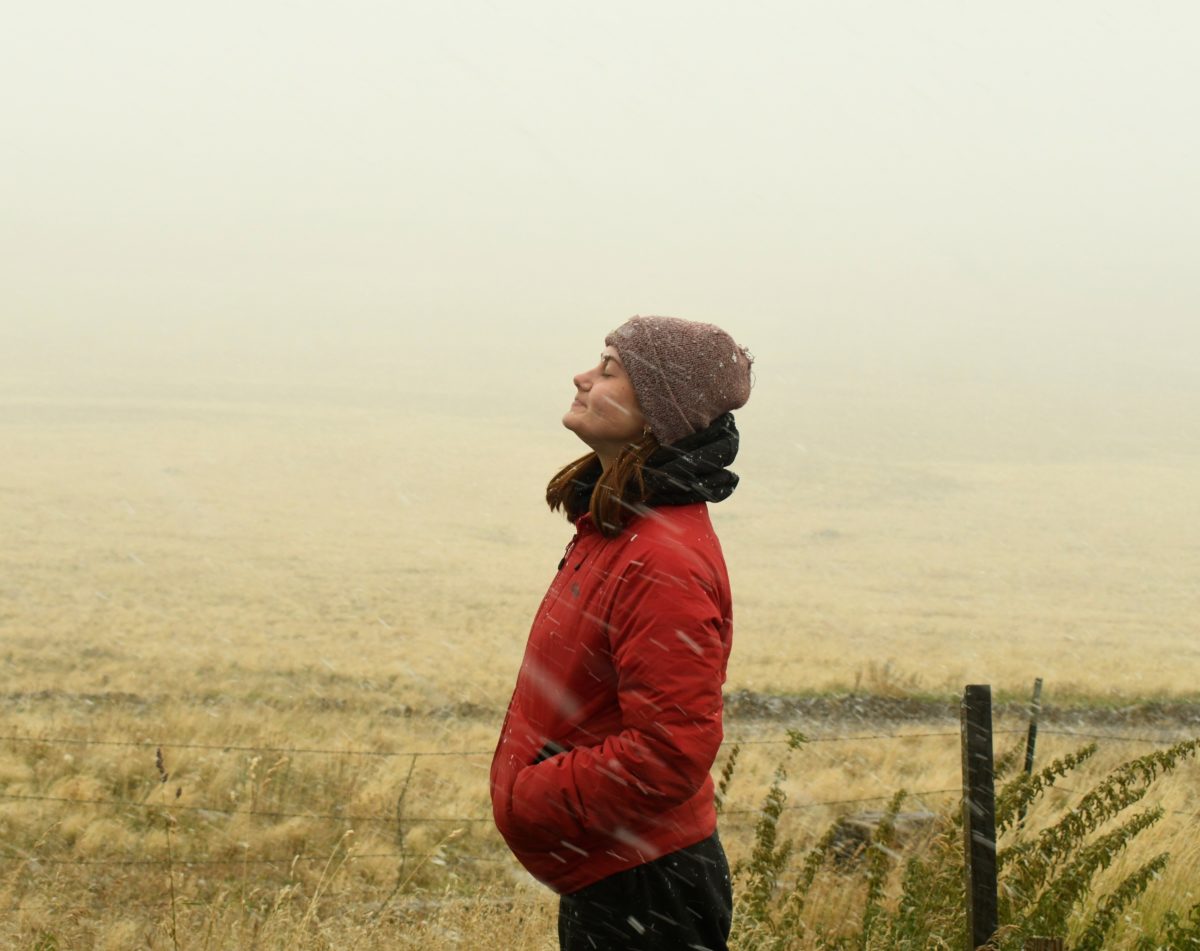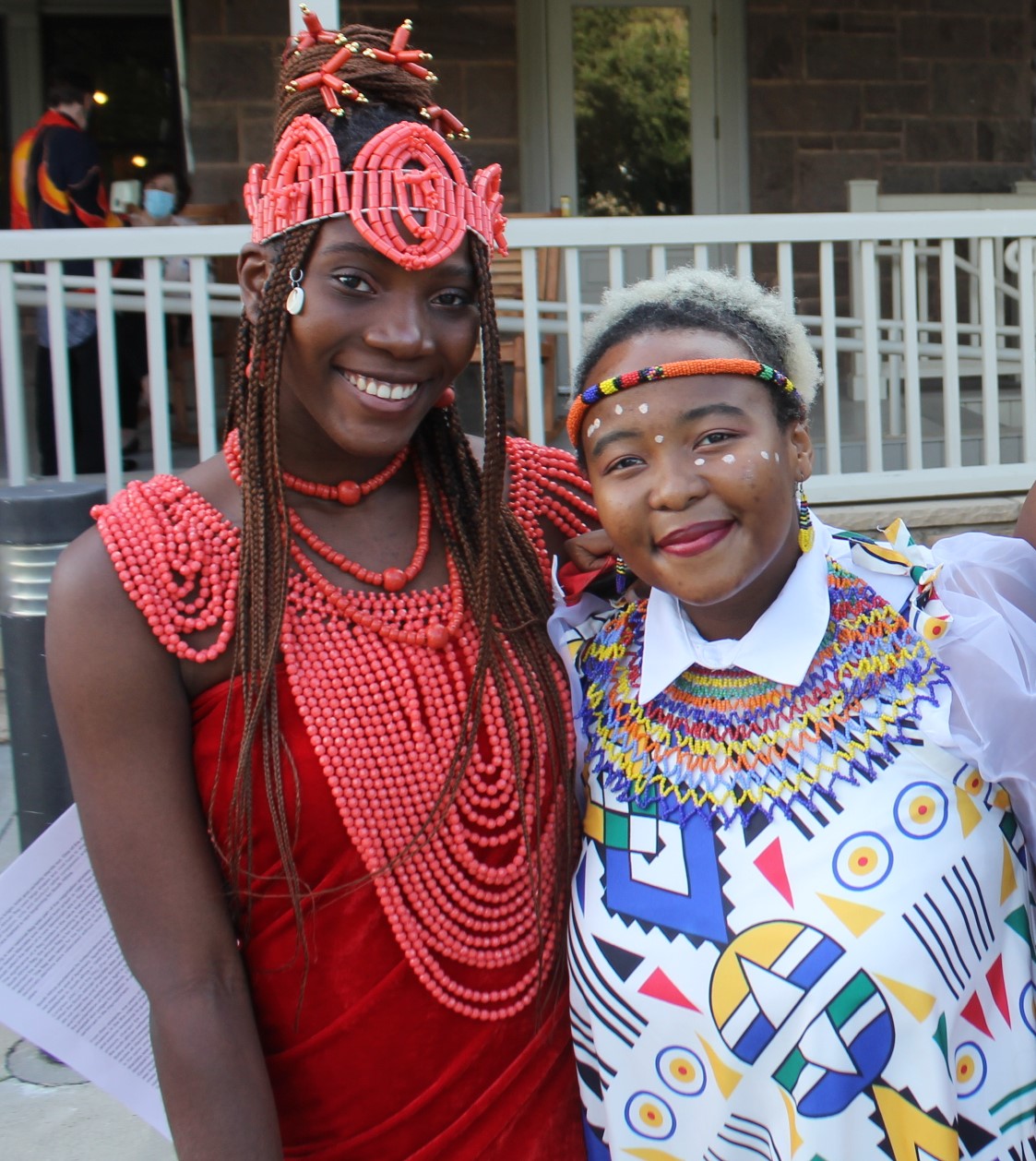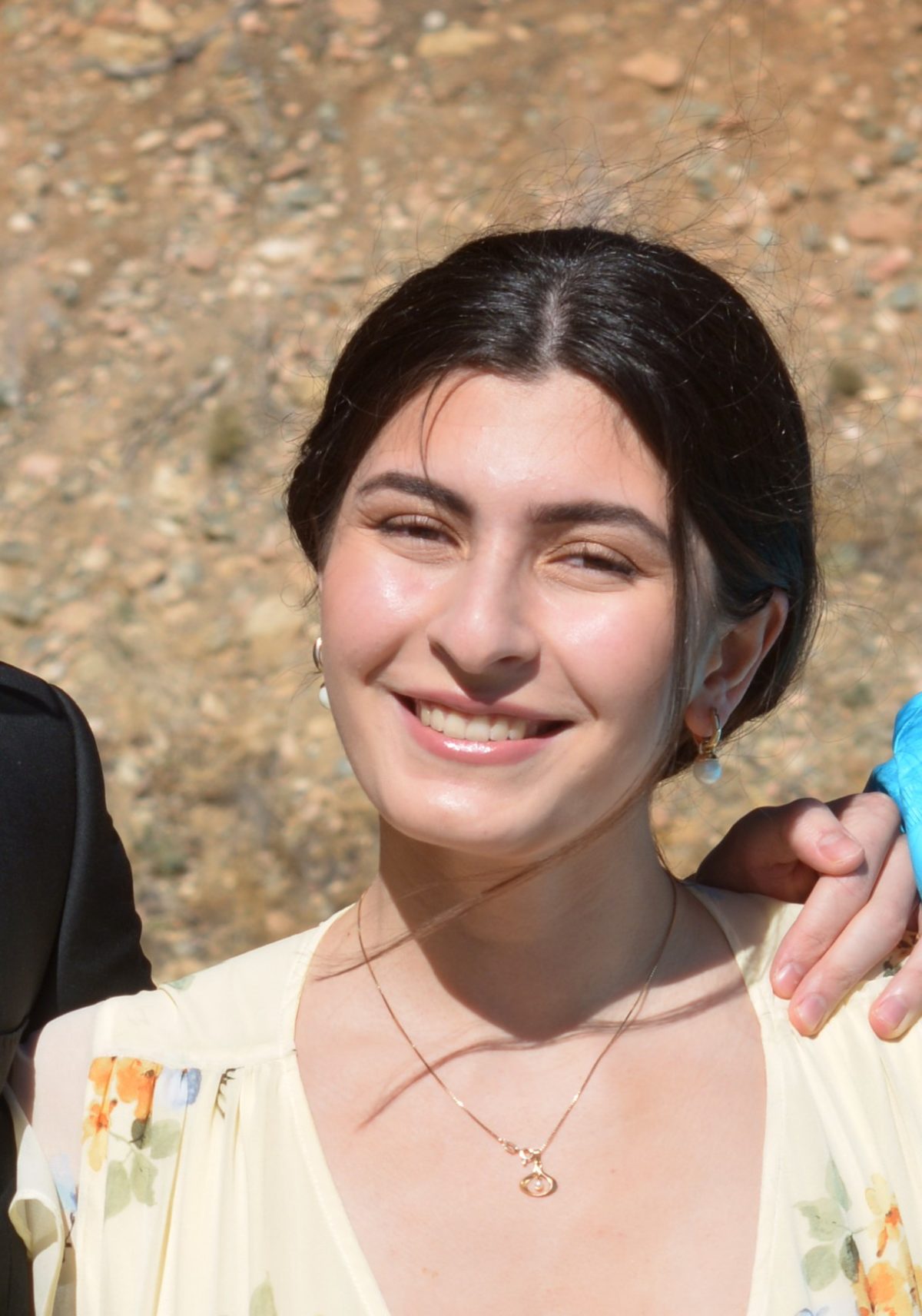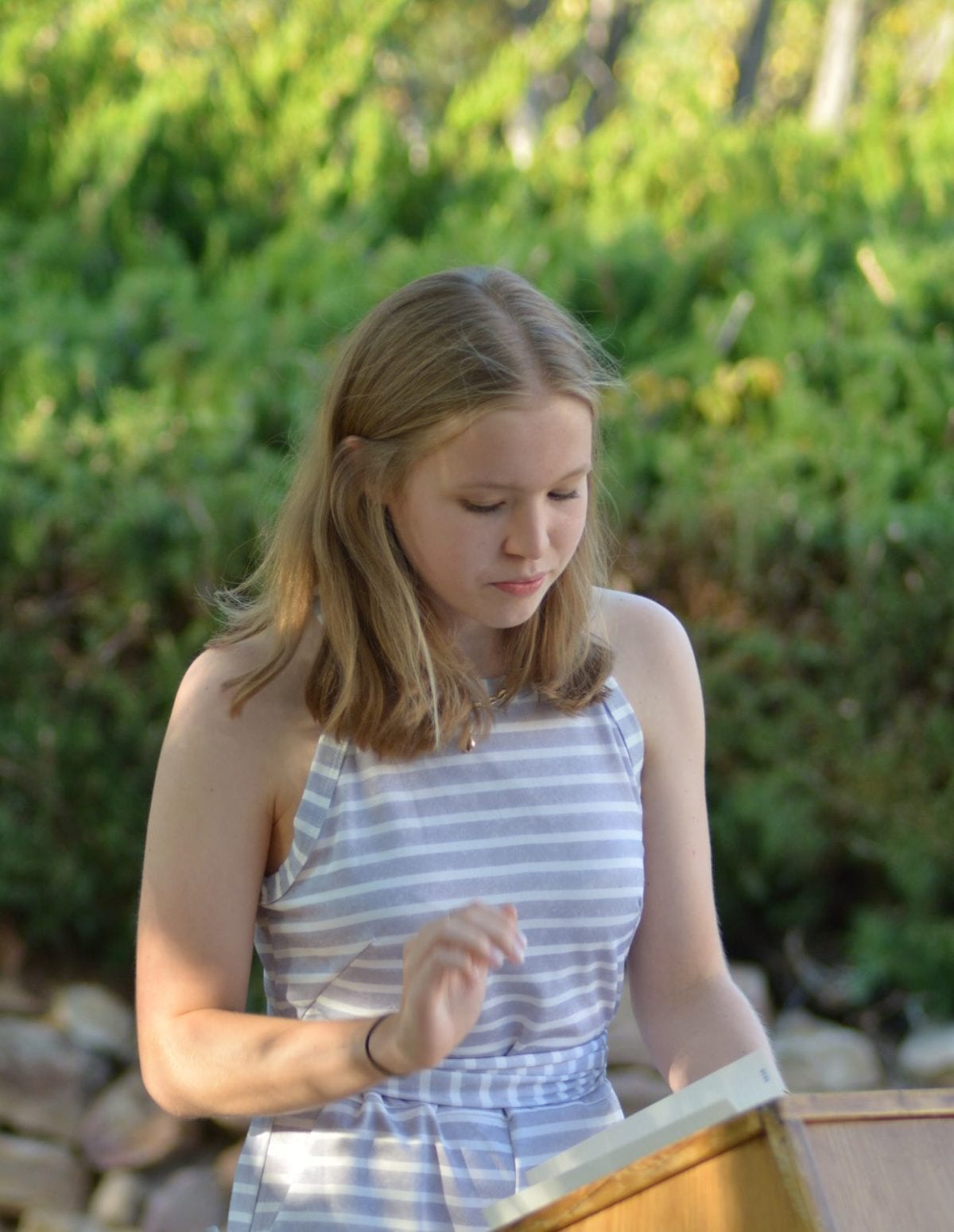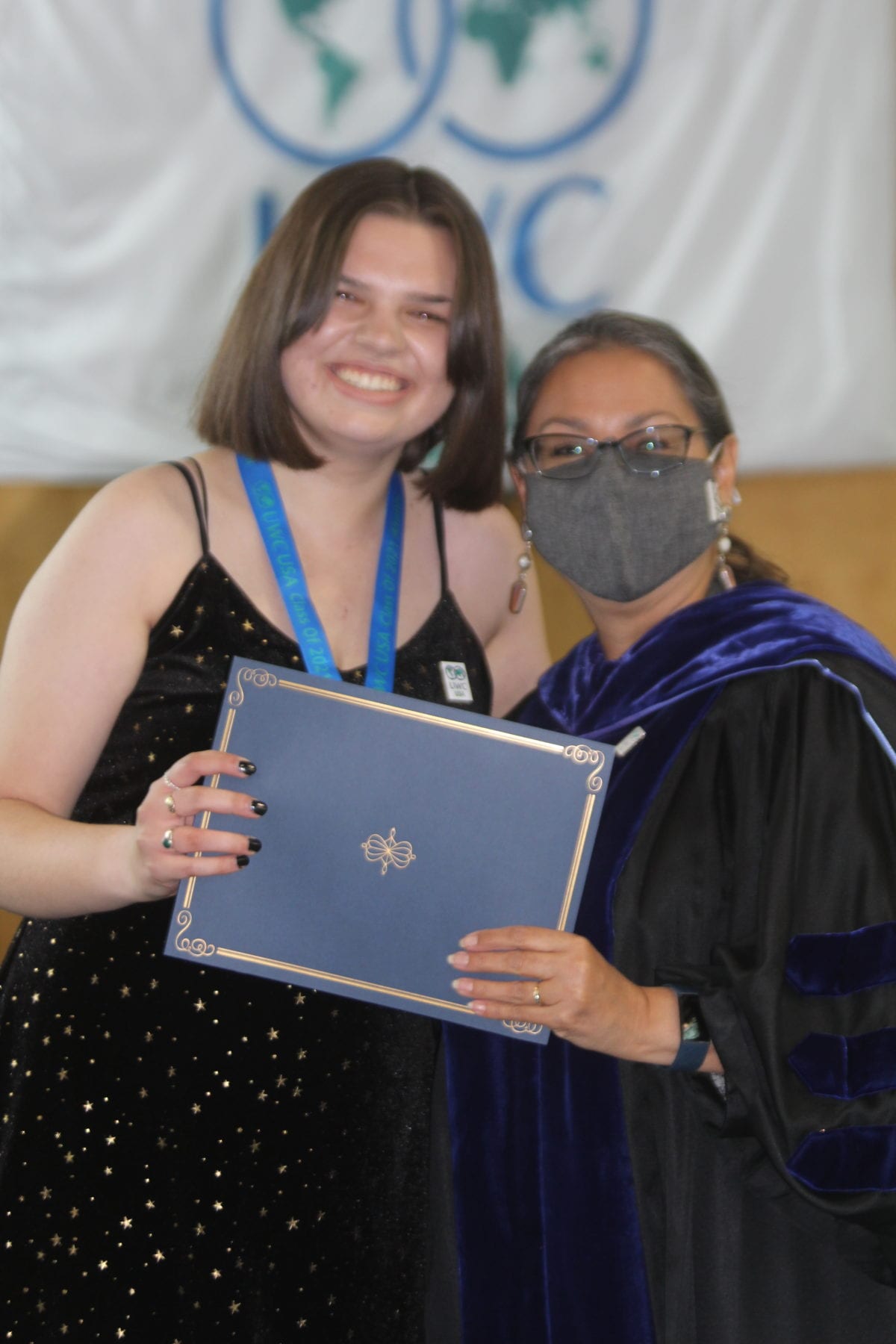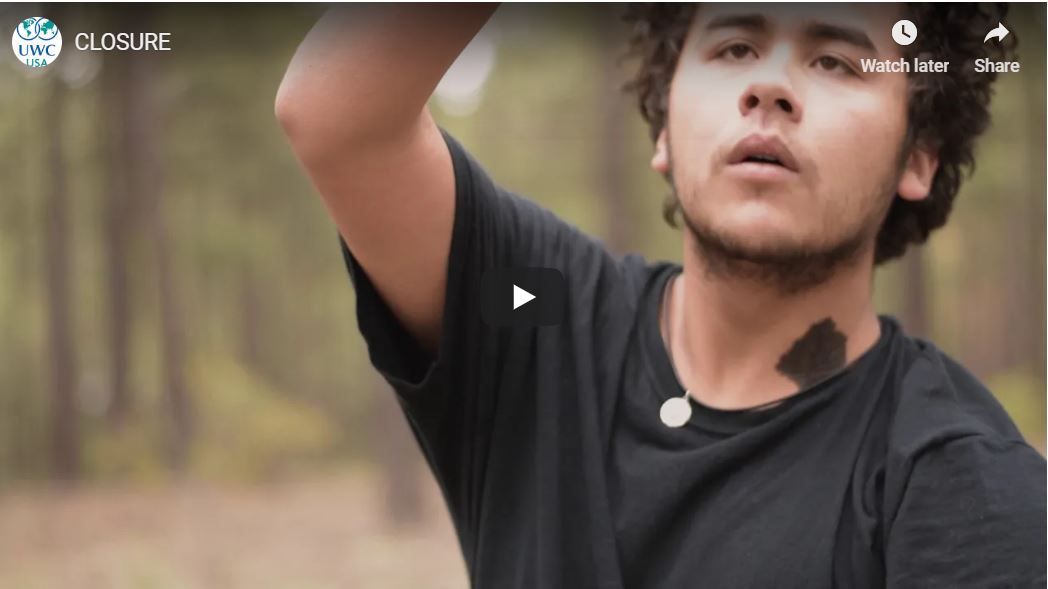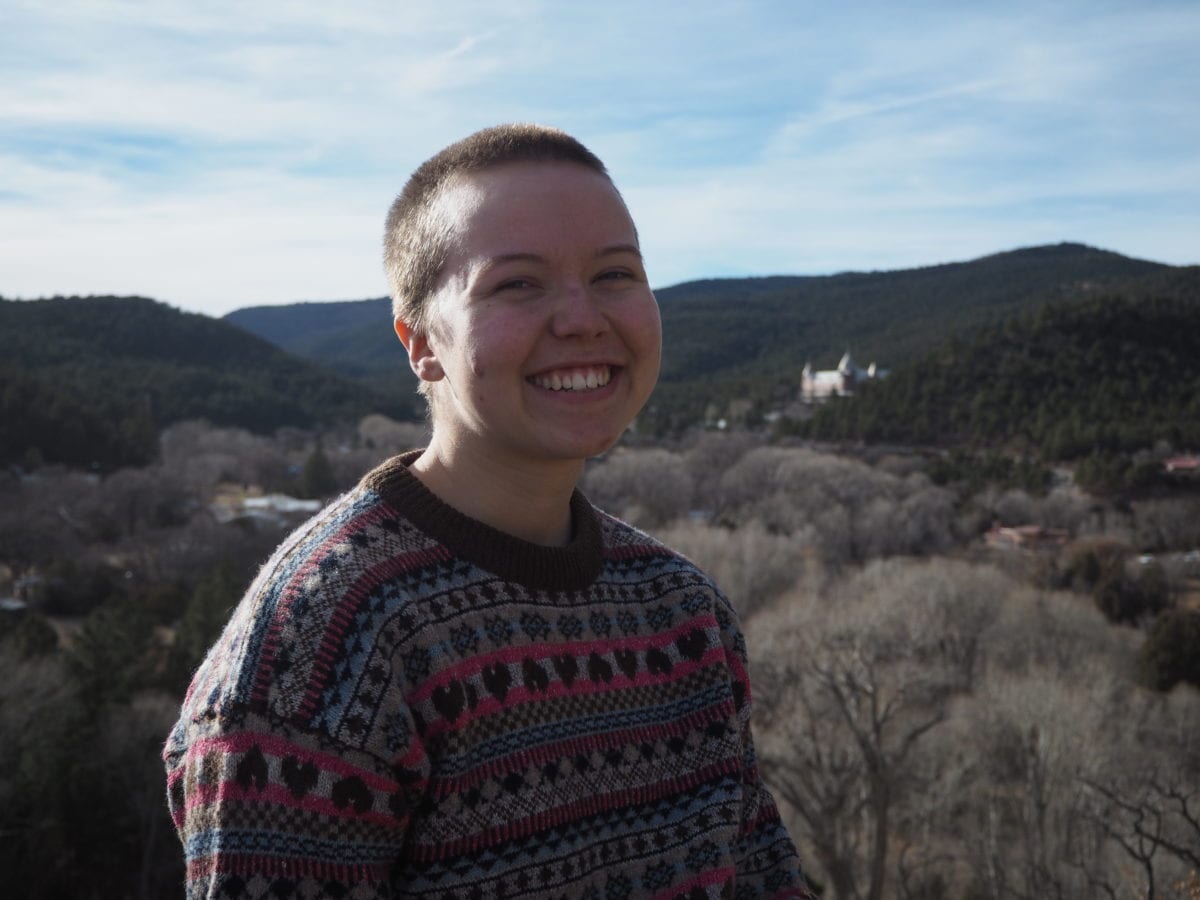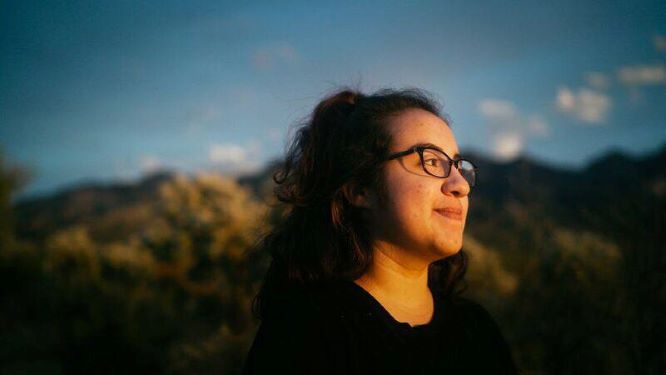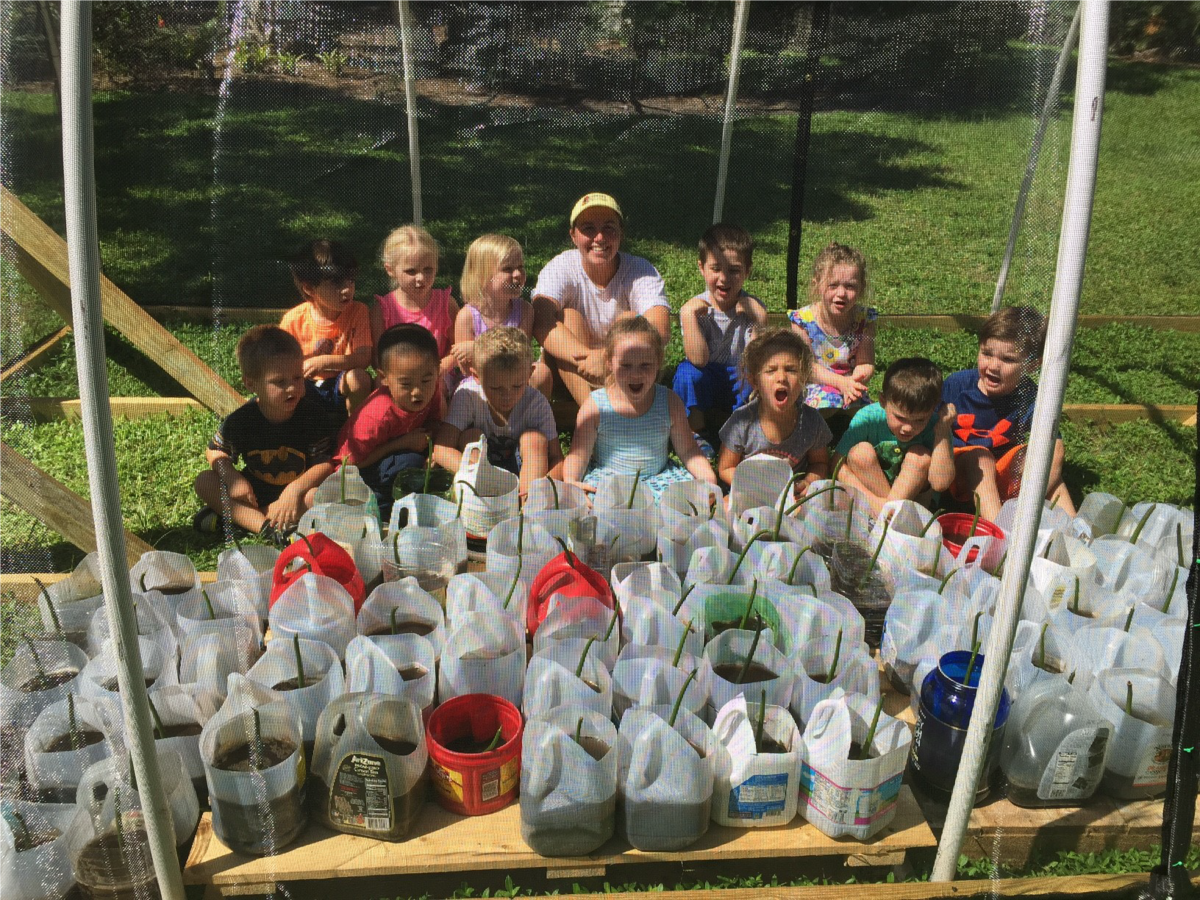My hands are chapped, my fingernails are broken and my pointer finger is bleeding. Still though, I squeeze hard on the handwarmers buried deep in my down jacket. Northern New Mexico is proving to be an inhospitable place in early October. Attempting to find respite from the cold, I stand under a ponderosa pine with my fellow Southwest Studies group members. We are at the start of a hike through Valles Caldera. I still haven’t digested the icy orange juice or hash browns, a special treat for Valiha’s birthday. We ate in a hurry as we stood shivering in merciless wind this morning. As Georgia would say, “I can’t be arsed” to do the hike. I miss the heat of the bus. Reluctantly, I trudge slowly along the trail, following the river. I can’t relate to the wonderstruck awe of some of my group members, mostly the ones from tropical places who have never seen snow. Just a few months ago I hiked in the same valley with my sister and we enjoyed a picnic lunch on the bank of the river. The landscape is unrecognizable now. My feet slide on the wet granite and I link arms with Celeste for all five of the bridge crossings. At the end of the hike we arrive at a lookout spot and share a snack of sesame sticks and almonds.
During the evening, after a dip in the hot springs and a dinner of bean burritos, our group huddles under a cluster of pinons. We are camped on a mesa. The view of the moon is unrivaled. She hangs wan and slender. She reminds me to loosen my grip of all the things I can’t hold. She reminds me of the persistence of change. This year, like all years, I cling in vain to summer. I cling to the calls of cicadas, slow Sunday mornings, and the blessing of opulent sunlight against my skin. The moon pries my fingers from this, folds my fist around a mug of echinacea tea.
When our plates are cleaned, we grow silent. And then, in the dark, a candle lit cake emerges, carried by one of the leaders. Valiha’s face glows as she blows out the flames. We all help suck the frosting off of the eighteen candles. She asks us to give her a present: to take each other’s hands. We do. Then, she says a prayer: “Thank you God for the burritos we had tonight- those were tasty. Thank you God for these amazing people here with me. Thank you God for the abundance you provide.” We voice a collective “amen.” Although I’m not acquainted with the God that Valiha prays to, I resonate with her prayer. We all do.
In the night, swaddled in eight layers, tucked into a zero degree sleeping bag, I sleep soundly next to three girls I’m so grateful to have gotten closer to over the course of the week. From the surrounding tents people call out goodnights and iloveyous and see you in the mornings.
Category: Student Blog
Reflections on the South African Flag
The following comments were shared with the UWC-USA community as part of the 2021 Welcome Dinner. Lwandile reflected on what the South African flag means.
The South African flag is bright, bold, and certainly stands out. One of the most colorful flags in the world, the South African flag uses large shapes and vivid hues to share the story of the country: a story of freedom, unity and ubuntu(or rather compassion and humanity). The end of the Apartheid era marked a new beginning for South Africa.
Choosing a new national flag was part of the negotiation process set in motion when freedom fighter Nelson Mandela was released from prison in 1990. The proclamation of the new flag would reflect the dawn of a new democratic era in South Africa. The significance of a flag resides in the value that humans give to it. When talking about the South African flag, the emotional meaning is very important. In order to understand how important the south African flag is for south Africa, we first need to know in which context it was approved. The flag was raised for the first time on the 26th of April 1994, the day in which the democratic elections were celebrated without racial discrimination. But let’s go back a few years.
South Africa proclaimed its independence from the United Kingdom in May 1961, but that did not mean the end of Apartheid. Apartheid is the name given to the segregation policy established in South africa in 1948 by the National Party (NP) and which the National African Congress (ANC) and the PAC (Pan-African Congress) demonstrated against. When the South African Republic was proclaimed, the country left the Commonwealth, but this did not mean the end of white domination nor the abolishment of the Apartheid regime. ANC and PAC leaders started their fight in favour of black people’s rights and in 1963, two years after the proclamation of independence, 17 members of the ANC (including Nelson Mandela), were arrested and judged for treason. A year later, Mandela and other seven colleagues were sentenced to life imprisonment.
From then onwards, the years of the greatest repression of the black population began. However, in the 80s internal changes occurred in the country (ranging from social movements and passive resistance to guerrilla warfare) and this, coupled with international pressure, changed the mood in the country. In 1986, president Botha of the NP announced that the South African parliament would “leave Apartheid behind them.” Three years later, in 1989, Botha was succeeded by F.W de Klerk, who in his inaugural speech announced that he would revoke all discriminatory laws, and he would legalize the ANC, PAC and the Communist Party. In the same year, on the 11th of February 1990, after having been in prison for 27 years, Nelson Mandela was released. A contest was held to choose the South African flag on the occasion of Mandela’s release. Nevertheless, none of the 7,000 models presented convinced the national Commission of symbols; and this is why a design from a proposal by Frederick G. Brownwell was finally chosen. His version of the flag was so well received that the interim version was made the final, national flag in the South African Constitution. Given the troubled historical context, it is remarkable that a consensual replacement for the former national flags was found. The new flag was seen as an enduring symbol of the modern South African state.
While officially there is no symbolism to the colors, some thoughts are that the red, white, and blue come from the British and Dutch colonial flags, and the black, gold, and green are from the colors found in the flags of liberation groups, including Nelson Mandela’s ANC (African National Congress) party.
But what does the flag mean to me and to my people? What does it represent?
The black isosceles triangle represents for me, the determination of Black people to thrive and triumph in troubling times, blue, representing truth and loyalty, red, the bloodshed during wars; bravery and strength, green, representing fertility of the land; love, hope, and joy for the land, yellow, appreciating the mineral wealth that is below the soil in which we reside and finally white, representing peace and honesty. The only concrete symbolism in the flag is the V or Y shape, which can be interpreted as “the convergence of diverse elements within South African society, taking the road ahead in unity”.
But are we really in unity? Although the flag represents important and powerful parts of my heritage and country, and although it represents a new era, post-apartheid, and is seen as a symbol of democracy and equity, it does not acknowledge the tremendous amount of work needing to be done. Because of the country’s further decline in economic, political, and social change, the flag sometimes reminds me of and represents the apartheid ideologies.
With the end of apartheid in 1994 the people of South Africa anticipated profound social and economic change. Yet twenty-six years later, much of the population lacks access to proper medical care and education. Despite improved access to clean water, housing, and roads, many South Africans feel that too little has changed since the apartheid era. The “rainbow nation,” in most cases, represented by this very flag, is still racially divided in its electoral behavior, and the income gap between black people and white people is greater than it was in 1994. Leading political figures in the current ruling party, the African National Congress (ANC), are often accused of corruption. New political groups are calling for the nationalization and expropriation of land and resources from the white minority. Nevertheless, the constitution enshrines the rule of law, and has popular support across all racial divides.
And so my question is, are the laws and institutions in place since 1994 strong enough to preserve democracy and the rule of law when the pace of social and economic change remains slow? Am I to be proud of the flag that I carry today?
UWC is a great place to start asking these questions. The Welcome Ceremony is an opportunity for us not only to praise, celebrate, and acknowledge our cultures and nationalities together, but to also start or initiate these conversations that help us bring ourselves closer to our identities and who we truly are. These are the moments that are available for us to recognize the truth of where we come from, positive or not, and create a foundation for reconciliation amongst our different countries, within our own countries, and amongst ourselves.
Shrin Ebadi: Battling for Rights
In a series titled Nobel Perspective, UWC-USA students and recent alumni reflect on the Nobel Acceptance Speeches of past Nobel Peace Prize winners. They explore how the Nobel Laureate’s view of the world matches events that unfolded since the prize was awarded and what still holds true for the UWC-USA community as it seeks to encourage students and alumni to be advocates for peace.
Shrin Ebadi, who received the 2003 Nobel Peace Prize, declared that the honor would inspire women across the Muslim world to fight for equality in oppressive and patriarchal societies. The prize was awarded “for her efforts for democracy and human rights” in Iran and her “struggle for the rights of women and children.”
Born in 1947, Ebadi trained as a lawyer and received her master’s from Tehran University before becoming the first female judge in Iran in 1969. Following the 1979 Islamic Revolution, she was dismissed from her role and assigned clerical positions because women were deemed unsuitable to serve as judges by the new leaders of Iran.
Although Ebadi was given a higher role within the department of justice after she and other female judges protested this action by the regime, she was still not allowed to serve as a judge. In 1992 she obtained her lawyer’s license and set up her own practice after years of struggle because the regime initially denied her license due to her gender and previous role under the Shah’s rule. Since then, Ebadi has represented various high-profile cases involving the families of political victims, journalists, and child custody matters.
In her 2003 Nobel Acceptance Speech, she claimed that “women constitute half of the population of every country. To disregard women and bar them from active participation in political, social, economic, and cultural life would in fact be tantamount to depriving the entire population of every society of half its capability. The patriarchal culture and the discrimination against women, particularly in the Islamic countries, cannot continue for ever.”
Although Ebadi did not make a prediction that almost 20 years later the situation for women would have become better, one cannot say that there has been a lot of progress either, especially in Islamic countries. Indeed the state crackdown on civil society, imprisonment of activists, internet and social media censorship, and the restrictions on operation of organizations are all obstacles to the women’s rights movements in Iran and most other Islamic countries.
However, the main obstacle is the discriminatory and patriarchal constitution in the Islamic Republic of Iran causing institutionalized discrimination for women and other marginalized groups. Therefore, as long as the constitution does not change, the rights for women in Iran will remain the same.
At the same time as she questions her own country’s human right treatments, she also boldly points out the hypocrisy of the nations who are founders and proponents of the rights that she is advocating for.
“The concerns of human rights’ advocates increase when they observe that international human rights laws are breached not only by their recognized opponents under the pretext of cultural relativity, but that these principles are also violated in Western democracies, in other words countries which were themselves among the initial codifiers of the United Nations Charter and the Universal Declaration of Human Rights,” Ebadi said.
Her criticism of the treatment of human rights in western states remains as relevant today. Recently, the EU court ruled that employers have the right to prohibit the wearing of “any visible form of expression of political, philosophical, or religious beliefs in the workplace.” This decision was based on cases brought by two Muslim women in Germany who lost their jobs because of their religious beliefs of wearing a headscarf.
This decision makes it more possible to continue to exclude Muslim women and other religious minorities from jobs in Europe. Ebadi said discrimination against women in the social, cultural, or political arena “has its roots in the patriarchal and male-dominated culture prevailing in these societies, not in Islam.” It’s not only Iran and other Muslim countries that have a patriarchal and male dominated prevailing culture; it’s the rest of the world. By comparison, many western countries are advancing women’s rights more effectively. But the comparison does not mean their work is completed.
Everyone is responsible for protecting human rights, and in her speech, Ebadi reminds us that it’s important to acknowledge fallacies and hypocrisies in 21st century politics across the world. At the United World College, we have a chance to acknowledge these weaknesses by having honest conversations with the cross-cultural student body. Recognizing and unwrapping these issues is the first step towards improving them.
However, we all need to take the next step, which is committing to include and encourage everyone. Although we don’t always get it right, I know from my experience at UWC that when everyone is encouraged to do more and be more — regardless of gender, race, sexual orientation, or any other perceived differences — we are able to achieve great things as a society. By teaching people to include and encourage, we can start working towards a more equal culture.
Parnian Ghaemi is from Sweden and Iran. She graduated from United World College-USA in Montezuma, N.M., this spring and will be studying political science and economics at Trinity College in Connecticut. At UWC she has particularly benefited from exposure to new ideas and diversity. She particularly enjoyed the lifelong cross-cultural friendships with students and teachers.
Willy Brandt: A Power Fully in the Service of Peace
In a series titled Nobel Perspective, UWC-USA students and recent alumni reflect on the Nobel Acceptance Speeches of past Nobel Peace Prize winners. They explore how the Nobel Laureate’s view of the world matches events that unfolded since the prize was awarded and what still holds true for the UWC-USA community as it seeks to encourage students and alumni to be advocates for peace.
In the Cold War, words exchanged between powerful politicians could change the entire world’s fate in just minutes. But, what if words were used for the better, in peaceful dialogue rather than furious verbal confrontations?
Willy Brandt, who was awarded the Nobel Peace Prize in 1971 for “paving the way for a meaningful dialogue between East and West,” pursued the policy of “change through rapprochement” and aimed to secure peace with his “new Ostpolitik.” Brandt became chancellor of West Germany in 1969, and the career that preceded this office impressed people and politicians alike.
Born in 1913 as the illegitimate child of a humble working-class family, his path took him from resistance against Nazism to a major contribution to the post-war political reconstruction and democratization of Germany. Brandt became an important — many would say iconic — figure in the Social Democratic Party, for which he became mayor of West Berlin, foreign minister, and chancellor of the Federal Republic of Germany.
He achieved meaningful steps towards reconciliation between East and West, and particularly between the two Germanies. This was not only significant in the context of the Cold War and the policy of détente, but also in the daily lives of Germans in Berlin.
In his 1971 Nobel Lecture, Brandt outlined his perspective on Europe’s role in peacekeeping around the world, and most importantly, his vision of foreign policy as peace policy.
He made the promotion of meaningful, constructive dialogue between government and people of sharply distinct ideologies a fundamental aspect of his legacy. Brandt wanted to make his country “a power fully in the service of peace” and focused his efforts as a politician on “the transition from classical power politics to earnest peace policy.”
While his efforts were arguably crucial in maintaining stability and avoiding confrontation in the East-West relationship, his vision of a new, peaceful Europe, in which co-existence between East and West would be possible, eventually proved to be enabled through the collapse of the Soviet Union in 1991. This collapse was triggered by the military and economic superiority of the rival West, which is very much the contrary of what Brandt had envisioned to be the driving force behind the transformation of the European continent that he anticipated.
Instead of continued rapprochement and détente beyond his administration, new crises evolved, setting the change for the pursuit of “classical power politics.” His beliefs in peaceful dialogue and “new Ostpolitik” were ultimately not the determinative factor that led to a new Europe and the end of the Cold War.
However, Brandt’s vision and his actions cannot be described as unsuccessful. They might not have achieved their aims, but they left behind faith and hope in his so-called small-step policy. In 1971, Brandt said “small steps are better than no steps at all,” and while he held bold, idealistic beliefs in a version of peace policy that consists of “dialogue rather than monologue,” the restoration of trust, and the absence of violence, he recognized that the vision of a peaceful world is unlikely to be achieved in individual large steps.
Rather, he trusted in a series of small-scale actions, which might sometimes feel meaningless to their performer, but which, in his view, were essential to the achievement of larger-scale change. With this policy guiding him, Brandt impacted lives, including Germans who could see their families on the other side of the wall over Christmas in 1963 and laid the foundation for the reunification of the two Germanies in 1990. His confidence in a small-step policy thus proved to have a meaningful impact on his career, German political history, and the lives of millions of Germans and Europeans.
Brandt’s career and his perspective can teach many students who come to UWC-USA an important lesson. Many students may hold bold, perhaps idealistic views, and we certainly all wish to affect change towards a more peaceful and sustainable world. Yet, actually being a changemaker doesn’t always feel successful. In fact, it might often feel insignificant to keep pushing for small-scale actions, to be activists and allies.
But the small-scale actions that we achieve as individuals and as a community are eventually what bring about meaningful, sustainable change. Willy Brandt, despite many controversies that also shaped his political life, essentially contributed greatly to a more peaceful world, and his “change through rapprochement” policy can and should be applied to today’s political world, too. Only through constructive dialogue and the tolerance of ideologies that oppose our own values will we be able to maintain peace and only then will we, at UWC-USA and beyond, be able to truly live our mission.
Marlena Samson ‘22 was born and raised in Germany, but international experiences, including studying in the United Kingdom at age 14 for a year, shaped her life. She is incredibly grateful for the opportunity to live the UWC experience at UWC-USA, and plans on continuing to learn from others when she goes to college. Marlena would like to study world politics and history.
A Bat Made Our Year Fly Away Too Fast
When in March 2020 the school closed down, I was heartbroken, as were many of my co-years and second-years. I could have had more sleepovers. I could have gone to Las Vegas more often. I could have hung out with second-years more. I could have put in the effort to hang out with the people I wanted to get to know. I could have cooked in the day room more.
Could have. Could have wasn’t good enough for my idea of life.
The pandemic made every experience ten times harder than it would have been otherwise. I could only see the smile of my best friend through her eyes. I couldn’t hug the people I hadn’t seen for five months when I first saw them on the field. I could only stare out of my window during quarantine and hope that it will get better. But I knew one thing. When I heard that we had an ExEd requirement for May 2020, I thought it would be some simple project. What I didn’t know was it would become one the best realizations I have ever had.
Whatever happens tomorrow, we’ve had today. And I had today. This year, I had so many todays I can’t even start to describe how grateful I am for them. The pandemic might not have been the easiest time for anyone, but it was a time for a challenge I didn’t know I needed.* Because of COVID, I made 7 new friends at the beginning of my second year, and can proudly say I have barely any moments I truly regret. COVID was hard from every aspect, from the uncomfortable and funny mask-line sunburns on my face, to the health risks of the campus and our families outside the campus. Yet, in spite of it, I am glad I learned that I want more out of my life than could have, I want today. The ExEd journey has definitely been one of the most important aspects to the revelation.
C L O S U R E: Student Dance Video
C L O S U R E
Reflections on Bathrooms and Friends: Commencement Speech 2019
Commencement Speech – May 25, 2019
Morgan Bakinowski ‘19
UWC-USA
In accordance with campus wide consensus, the Kili dormitory bathroom is quite a vile place. Leaky shower heads drip into shallow stagnant pools that collect by the drains. A particular aroma of musty towels and faintly perfumed soap engulfs the space. When you think of UWC-USA, it’s a place often left off the promotional pamphlet or prospective student or donor postcard. It’s something so seemingly ordinary – a necessary universal accommodation of any living space. It’s not the beautifully manicured grounds, it doesn’t carry a generous name, and it certainly doesn’t have a Chihuly chandelier in it. However, when I reflect on my time here, recalling the most meaningful conversations I’ve had, the people I’ve grown to love, and the way in which my own opinion has evolved and blossomed – I am constantly brought back to that narrow, soggy little bathroom down the hall.
This is because to me UWC-USA isn’t about the things you’d expect. Before arriving, I dreamed of myself changing the world overnight, galvanized by my diverse peers as advertised online. When I read and the mission statement and came across the word “force”- I fell victim to the intrinsically human notion of a “before” and “after” mechanism. Before UWC-USA, I was a student. After UWC-USA, I would become a master of peace-making. However, life is seldom a cause and effect, black and white, or wrong or right matter. Change-making doesn’t operate it a formula, and UWC – or anything else for that matter – doesn’t guarantee solutions to differences. What I experienced in that dimly lit space wasn’t something I’d take an IB exam on and pass or fail – defining my moral and arrant worth in the world and qualify whether or not I was able to change it. What I discovered was the beauty of individuality and how “peace” doesn’t mean everyone having the same, hyper-liberal idea. How “peace” can be more accurately defined as coexistence rather than an absence of conflict. How “peace” can be achieved in literally any setting, even in the places we ~~relieve~~ ourselves.
The most important part of any interaction is listening to what others have to say while sharing your own opinion with the mutual goal of enriching each other’s understandings. I listened to my friends and peers pour their souls out into those ceramic sinks and quite often I found myself sharing experiences, opinions, and doubts of my own I wouldn’t before even fathom speaking aloud. I realized the truths I had championed paired completely conversely with the convictions of others, but that at the end of the day, we’d both wash our faces and brush our teeth under the same turbulent taps.
Languages, cultures, religions – they all amount to a unique cosmos of dissimilarity that we have witnessed provide a foundation for unmatched community strength here at UWC-USA. Examples of this phenomenon happened around every corner, in every classroom, and in every dorm – providing a constant reminder of the shared nature of the spaces we inhabited. Whether it was an exchange that lasted for hours standing in the mirrored doorways of the bathroom- or simply a “hello” or “goodbye” in brief passings to and fro – our witnessing forced the acknowledgement of the presence of others. 2am conversations about philosophy and existence rang over the sound of the shower heads’ incessant dripping. Music from all over the world blared from every corner of the stalls. Human truth was humbled by living together, revealing the dirty, gritty, simple reality of a shared existence through this shared space.
Illuminated through the accessibility of a bathroom, the truth of UWC-USA’s impact was bestowed to me. To be a better citizen of tomorrow doesn’t necessarily encompass doing something presumably extraordinary. Having the ability to share a space, despite differences, despite nationalities, despite beliefs – doesn’t always require a revelation of extreme magnitude, and in itself is extraordinary. At the end of it all, tolerance and a celebration of variability gives us strength. Witnessing the power of human connection doesn’t require an endowment fund or a castle, rather, it’s the circumstance of bringing us all together and the simplicity of the experiences we share that shines light on what it means to be a better citizen of a community – whether it be as small as the Kili bathroom, or as profound as the world.
Five Things Everyone Can Do to Live the Sustainability Part of the UWC Mission
UWC Mission Statement: “UWC makes education a force to unite people, nations, and cultures for peace and a sustainable future.”
As a part of UWC-USA’s experimental education (exed) program, the Enviro Group was established at the beginning of this school year to address issues of sustainability and energy consumption on our campus. The student-led group aims to communicate with policy-makers of the school as well as inspire the student body to be conscious about their daily choices on campus. The mission statement of Enviro Group extends the sustainability part of the larger UWC Mission statement: “Enviro Group aims to promote a more sustainable future by raising awareness of environmental challenges, encouraging sustainable actions and reducing our ecological footprint at UWC-USA and beyond.” Below are some ways everyone can help promote sustainability, whether they are a UWC-USA student or not.
1: Transportation
Transportation and especially flying are some of the biggest dilemmas in the lives of UWC-students when it comes to the sustainability part of our mission statement. Going home is an integral part of staying connected to our cultures and families, but we all could do something different at times. Try going outside your comfort zone, and look at the environment you are living in. All the 17 UWC schools are located in vastly different environments, and they offer numerous opportunities for spending a spring break, winter break, or even the summer within the country or the nearby region. Look for alumni who could host you, get to know local people and ask what they love about the place or apply for programmes that include board. Travelling across the region with a train or bus with your classmates can also provide unforgettable memories – with less greenhouse gases produced than flying home.
2: Rethink Your Diet
The issues with dietary habits at UWC-USA can be somewhat more complicated when each of us has a very different view on how food relates to culture and values. However, the cold truth is that eating lots of meat- and dairy-based foods contributes to global warming significantly more than a plant-based diet. The animals need to be fed before they or their products end up on your plate, which is the single biggest reason why a vegan diet is so much less energy-intense than one based on animal products. There are as many different ways to be sustainable through eating as there are eaters: switch regular milk to soy or almond milk in your coffee and cereal, try filling up your plate from the salad bar instead of from the hot food station or double up on fruit to replace the dairy- and sugar-filled desserts. Giving up certain foods for life is not the only way, but be curious and try different things for once. (Check out the healthy and sustainable diet by EAT-Lancet Commission that is designed to feed 10 billion people.
3: Energy Consumption
At least at the border between the great plains and the southern Rocky Mountains, where UWC-USA is located in Montezuma, water can be scarce sometimes. We all love long and hot showers but they require tremendous amounts of water and energy, plus they may annoy your dorm mates who would also like to shower. Make a shower playlist that is only two or three songs long if you tend to enjoy your shower parties a little too much. Or you could even put a timer on your phone. Go to the Hot Springs to warm up! Don’t keep the water running when you soap your hands, brush teeth, and wash dishes. The electricity sources used on campus are also not really under the control of students, but remember to turn off the lights in your room when you’re not there and only open the window when this can actually improve the temperature in the room. Keeping the blinds shut at night helps to keep the room insulated as well, which may prevent the need for an extra heater.
4: Circular Economy
One of the greatest things about living on UWC-USA’s campus in Montezuma, NM is the fact that nearly everything can be borrowed. From a screwdriver to a mixing bowl to a nice skirt to a phone charger – just ask around and you can avoid buying it. This saves you money as you don’t need to buy new things and is also better for the environment: producing new consumer goods may be fundamental to Western capitalism, but we often neglect simple ways to share resources.
5: Know Where to Shop, and What to Shop For
After you have figured the things you can borrow or buy from others (or even make yourself) you probably still need some things that you need to buy from the grocery store. While Wal-Mart is the easiest option, and that is where the school buses take us without further consideration, there are options to Walmart which has been accused of exploiting its workers and is the endless supply of too small and easily breakable plastic bags. Check out smaller grocery stores and those that possibly have local owners: usually they have a larger supply of local products and this way you can also boost the local economy. Support local farmers and check if there is an organic version of your favourite fruit or snack available.
In the end, these are small decisions and habits that we can all work to adopt. Maybe we can’t all do all of these things, but if we can commit to start putting three or four of these ideas into action, we can make a difference!
Reflections on Project Week: Tucson and the Border
Mangrove Project – Morgan Bakinowski ’19
Morgan Bakinowski ’19 developed and implemented a mangrove restoration project in her home community recently that involved (in true UWC fashion) education for local students, volunteerism for community members, and support from local businesses and schools. Morgan supplied UWC-USA with the following report of her work:
Mangrove Project: Indian River Lagoon
From humble beginnings at Alphabet Farms Preschool in Palm City, a large crop of red mangrove seedlings has been successfully transplanted into the Indian River Lagoon. After learning about mangrove ecosystems, environmental sustainability, and recycling, the kids at Alphabet Farms (ages 4 to 6) planted over 100 propagules last August in reused plastic milk jugs. With hard work, and the lives of the thousands of perishing fish and birds of the lagoon in mind, 100% of the initial crop survived. Even in preschool, a place many consider “square one” in education, Martin County is perpetuating a future generation of environmentally-aware leaders.
The transplant, carried out with the help of the Environmental Study Center’s Camp W.E.T, was also a huge success. 5th grade campers took to the river aboard the “River Scout” and dug holes for nearly 60 red mangrove seedlings. Focusing on the habitats these plants create, the kids learned about the enormous range of estuary creatures that depend on mangroves. They also focused on mangrove roots as areas for barnacle beds to grow and develop. While the sprawling roots help eliminate floating debris, barnacles filter the water further, fine-tuning water quality and combating the detrimental effects of the Lake Okeechobee discharges. With a record-breaking summer of rains and releases, the pressing threat of blue-green algae on biodiversity is becoming more and more apparent. Rather than waiting around for the day they could no longer swim in the lagoon or see the dolphins playing by the sandbar, these kids helped take a stand in the sand.
The other 50 mangrove seedlings were donated to the Florida Oceanographic Center to be used for research and coastline rehabilitation. In a groundbreaking new project the FOC has launched, the mangroves will be transplanted in the middle of artificial oyster beds. By layering bags of empty oyster shells collected from local restaurants and bars, the shell formations will provide a place for new oysters to cling to. Adorned with a mangrove seedling in the middle, the roots will grow around the formation, ensuring that changing tides and intensifying storms won’t impact the shoreline and suck up the sand. Think of it as a less dramatic, environmentally integrated sea wall, but without the negative implications of ecosystem disruption. These structured aids are helping to rehabilitate the estuary, creating more space for wildlife and safer, more biodiverse coasts for us all to enjoy.
None of this would have been made possible if not for the support of this community. From wood and soil donated by our local HomeDepot and Pinder’s nursery, to milk jugs and plastic containers divided from neighbors’ recycling bins, this has truly been an uplifting example of a community coming together on multiple levels in order to face and deal with a pressing environmental problem. I hope people will see this project as an illustration of a new, mobilized, youth-based force of citizens we are all witnessing take action in Martin County. I want to be a part of a generation that cares about how our decisions impact the environment. After all, beyond just the health of our waterways, it’s our futures we’re protecting. Moving forward from the success of this year’s crop, the plan is to double the seedlings for next year. I can’t wait to collaborate with these schools and organizations again in order to have twice the positive impact.”

